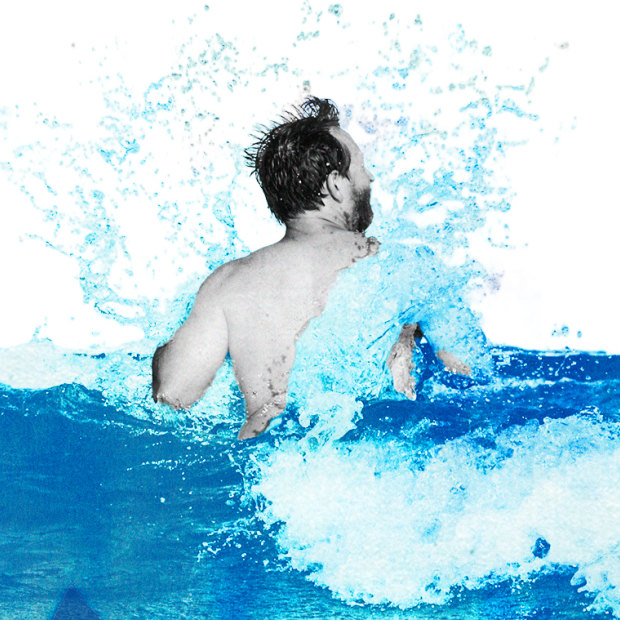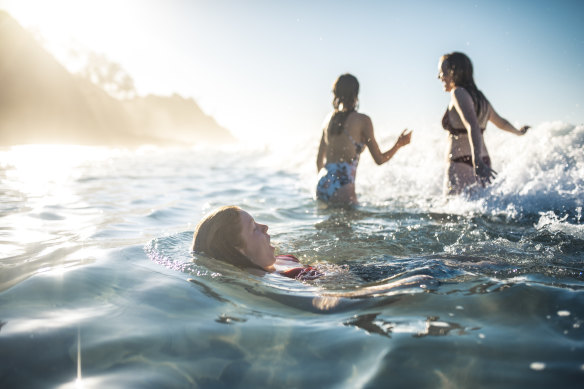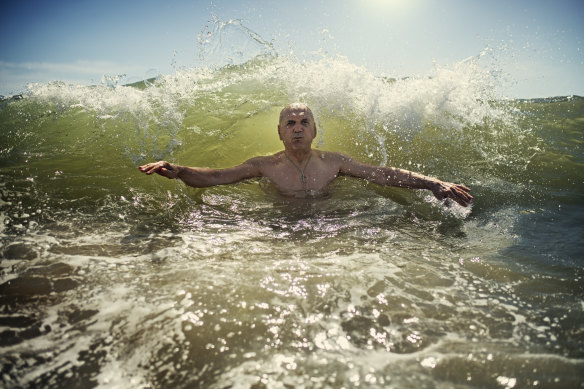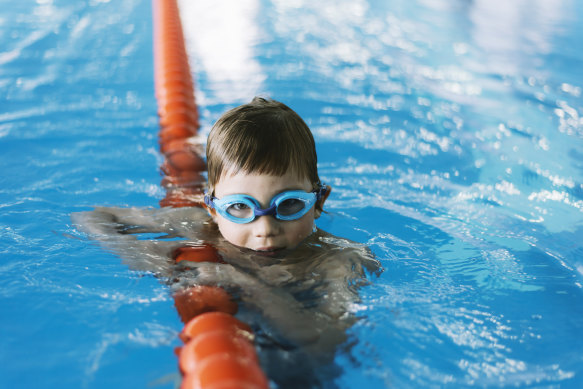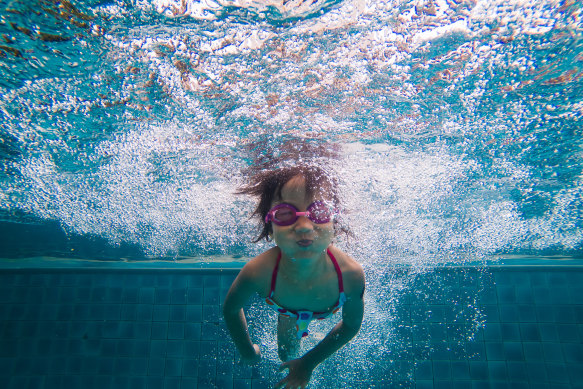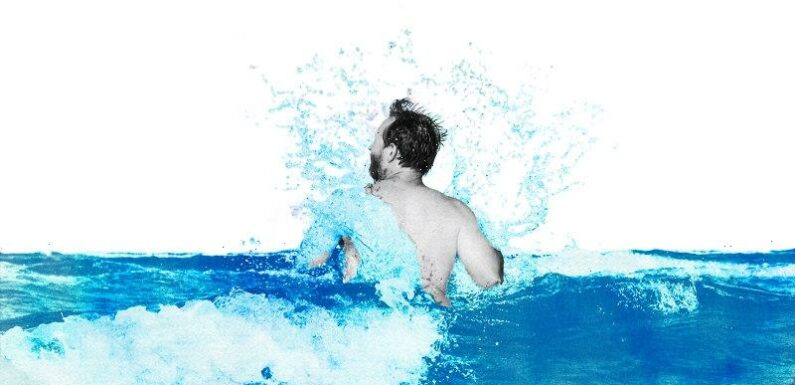
Many drownings are not noticed until it’s too late. Who is most likely to drown? And how do you spot someone in trouble?
It took more than four minutes for anyone to notice the five-year-old boy who appeared to have drowned in a small pool within touching distance of families and other children.
When drowning experts reviewed a video showing the boy floating face down for several minutes, they were shocked. It was nearly impossible to watch, even for people whose work is saving people from drowning. But the unconscious boy was resuscitated and survived. Unlike many non-fatal drownings, he suffered no lifelong injuries.
About 320,000 people die from drowning every year, including an average of 274 in Australia, according to the World Health Organisation.
In Australia, 145 people died from drowning during the summer of 2021-22, a 44 per cent increase on the 10-year average of 101 deaths in summer. After trending down for years, drowning deaths increased in 2021-22 by 15 per cent on the previous year, and by 24 per cent over the 10 years average to 339 people.
How does drowning happen – and to whom? Why didn’t anyone hear that five-year-old’s cry for help? And how do you spot someone in trouble?
And a warning: this content may be distressing.
Credit:Artwork Aresna Villanueva
Why didn’t anyone hear the boy’s call for help?
Because he didn’t call for help. Contrary to the Hollywood stereotype, nobody in any of the 23 videos reviewed by international experts waved or called for help. (The videos were from closed-circuit cameras and from people who had realised they had filmed a drowning only after the event.) That backs up what lifesavers see on beaches and in pools and rivers.
"There was a clear debunking of that theory," says Dr Shayne Baker, a lifesaver who has pulled hundreds of people out of the water in his 25 years of volunteering on some of Queensland's most dangerous beaches.
In November 2020, a video went viral that captured the recovery of a 24-year-old Chinese student who fell in a river. She made no noise and floated face down until she was rescued by Stephen Ellison, a British diplomat and consul-general.
In half the videos studied by experts, bystanders swam, walked or waded near the person in trouble. In the video of the boy, he is seen trying to reach the edge of the pool. He makes it momentarily, only to drop in exhaustion next to adults chatting in the shallows. Face down beneath the water, his limpbody is carried by the movement of the water across the pool. He comes to rest next to a woman who raises the alarm. “It is bizarre,” says Baker, who participated in the study. “When you are watching the videos, you think, how can you not see this child is not coping? They are not playing; they are fighting for their lives.”
Other videos show people swimming laps over the top of people who have sunk after only a few strokes, and children whose flotation devices have capsized, trapping the child upside down beneath the water in both a pool and a large bath. “The idea that you are going to get a clear sound, or indications, such as raising arms above the water, is wrong,” says Baker, who is also Royal Life Saving Australia’s education and training national adviser.
Not only is drowning a “silent killer” but it can happen quickly, found drowning prevention expert Dr Amy Peden, a lecturer in injury prevention at the University of NSW. In the case of the boy in the video, his mother had left the pool to have a sauna with a friend, presuming he would be safe surrounded by adults and children.
Peden studied the drowning deaths of 447 children under five in which coroners ruled distraction was a factor. A child can die in the time it takes to hang out a load of washing or stir food on the stove.
And new research released in November found the risk of a child drowning triples following a child’s first birthday. It found 40 per cent of the 549 drowning deaths of children aged zero to four over the past 20 years occurred when a child was one, and crawling or walking. Half occurred in pools.
Housework inside the home – ironing and cooking – were contributing causes in about 125 deaths (about 28 per cent). Hanging out washing and other outdoor jobs and chores contributed to 13 per cent, and talking, socialising and playing with mobile phones about 21 per cent, found a paper by the University of NSW, James Cook University and Royal Life Saving Society Australia. (Peden says this provides an excellent reason to ignore the chores and play with your kids instead.)
How can you tell that someone is drowning?
Until the advent of mobile phone and surveillance cameras, there was only anecdotal evidence from survivors of non-fatal drownings about what happened and how they reacted. But the videos of people drowning found 19 were rescued before they became unconscious and five were unconscious.
Baker says the videos show that people who are trained to respond – lifesavers and lifeguards – are able to spot someone in trouble much faster than untrained bystanders. In more than half of the videos, bystanders failed to recognise any signs at all.
Baker says when weak swimmers begin to tire, they usually have trouble with any over-arm action. This is followed by changing to underwater arm action and then they are more upright in the water and are looking about for the closest point of safety or exit. He says they tend to lose any capacity to propel themselves forward. They often look like they are attempting to climb an underwater ladder or pushing their arms down behind them.
“While there might be great deal of arm action, it is not guiding or directing them in any particular direction. They have already begun to drown …”
“With this person, you know you have a small window of time to respond and assist or retrieve them from the water.”
Most swimmers don't have the experience or skills to know to float and raise an arm. It sounds obvious, but watch for people whose faces drop below the water and don't surface fully to take a breath.
Someone who can’t swim will struggle to lift their head clear of the water to breathe and will have no control or capacity to control their body position/rotation. “While there might be great deal of arm action, it is not guiding or directing them in any particular direction. They have already begun to drown and need an urgent response and intervention to minimise the drowning cycle,” says Baker.
Credit:Getty Images
What happens when a person is drowning?
Australia’s former surgeon general Professor John Pearn, a pediatrician, describes drowning as a hypoxic march of events that reduce oxygen to the brain until none flows at all.
When someone falls into water, they involuntarily hold their breath. That causes their pulse rate and blood pressure to rise until they reach "break point," says Pearn, who is also the national medical adviser to the Royal Life Saving Society Australia.
That’s when rising levels of carbon dioxide cause a receptor in the brain to fire off an irresistible compulsion to take a breath, says Pearn. Virtually all children, though, have a “brain-sparing diving reflex” that delays the intake of breath to provide them with an extra 30 seconds.
It takes an average of two minutes for someone drowning to become unconscious. That’s about the time it takes to brush your teeth (properly).
There comes a time, though, when everyone has to take a breath and you can't get your head above the water, says Pearn.
“It is a terrible moment,” he says. “Against one’s will, one has to inhale, and the water hits the larynx at the back of the throat.”
Think of what it is like to have a drop of water go down the wrong way, he says. In a drowning situation, water rushes into the lungs, causing the person to become unconscious.
“At this stage, the heart is still beating, racing to overcome the lack of oxygen, up to about 200 beats a minute,” he says. “Finally, the heart will slow down because it hasn’t got any oxygen. Usually, they’ve been unconscious for three to five minutes in the water.”
It takes an average of two minutes for someone drowning to become unconscious. That’s about the same time as it takes to brush your teeth (properly).
Would holding your breath delay this response? It may but even if you could, you shouldn’t. Most people can hold their breath for only 30 to 60 seconds. Female Japanese divers can last two minutes — long enough to retrieve pearls.
Although schools once had competitions to see who could hold their breath longest, experts recommend against hyperventilating or breath holding before or during an endurance underwater swim. It can disable the “safety receptor” and cause some people to lose consciousness. Or, as Pearn describes it, “if the drive to breathe is lost, unconsciousness from cerebral hypoxia may occur before the hypoxia-induced breakpoint is reached.”
Credit:
Who drowns and where?
Men. Four out of five people who fatally drown in Australia are male, with similar figures in most developed nations. The proportion of men who drown compared to women hasn't varied much since 1894, when the Royal Life Saving Society Australia began keeping records.
In the decade to June 30, 2230 men fatally drowned. Men represent 85 per cent of all fatal drownings among people aged 25 to 64.
Research by the Royal Life Saving Society Australia found 40 per cent of the men who fatally drowned in the past decade had drugs or alcohol in their systems. Of the men who had been drinking, two-thirds were above 0.05.
Men who fell by accident or jumped into water off rocks, bridges or river banks and subsequently fatally drowned were far more likely to have been drinking than others.
Other research has shown men overestimate their swimming abilities, and their assessment of their skill doesn’t match reality.
Matt Naysmith was known for being a party boy – or, as he says, for making “stupid decisions” and taking risks when he had been drinking. His worst decision was when, as a 21-year-old drinking with workmates at Fern Pool in Karijini National Park, Western Australia, he ignored signs that said “no climbing” and jumped off a waterfall. He slipped and crashed onto rocks. He is now a paraplegic.
Why do men drown at a much higher rate? Peden says men are more likely to engage in high-risk behaviour, they’re more likely to spend a longer time in deeper water compared to females, more likely to drink and swim, and eschew lifejackets.
Other research has shown men overestimate their swimming abilities, and their assessment of their skill doesn’t match reality.
Young men are also most at risk of getting caught and drowning in a rip current, says Surf Life Saving Australia.
In the 12 years to 2021, rip currents claimed 230 lives; half were males aged between 15 and 39. On average, 21 people drown each year in rip currents, adding up to around 230 in the 12 years to 2021.
Shayne Baker often asks people about to venture across Tallebudgera Creek, where it meets the ocean at Burleigh Heads in Queensland, whether they are strong swimmers. The tidal waterway looks inviting, yet rips and strong currents have been known to carry swimmers onto rocks and out to sea.
Many will say, “Yes”.
Baker will then ask, “So, you swim an average of 12 kilometres to 16 kilometres a week, right?”
Uh, no. His definition of a strong swimmer is very different from that of most people who may swim for fun in pools and at the beach.
Falling into water is also a great risk for children. Over 2021-22, 17 children under the age of five fatally drowned, representing about 5 per cent of total drownings (and a fall of 23 per cent compared to the 10-year average). Of those deaths, most were toddlers about one year of age.
In 2021-22, people (nearly all male) aged 65 to 74 years represented the largest group of drowning deaths (16 per cent) followed by 35- to 44-year-olds at 14 per cent and 25- to 34-year-olds at 13 per cent.
Compared to the 70 fatalities that occurred on beaches over the previous year, twice as many died on inland waterways including lakes, dams, rivers and creeks. Fishing on rocks without a lifejacket also causes around 15 deaths each year. In contrast, 23 people fatally drowned in pools.
Credit:Getty Images
Isn’t all drowning fatal?
The definition of drowning is the “process of experiencing respiratory impairment from submersion and/or immersion in liquid”, according to the World Health Organisation. Some submersion results in death but many other people experience a non-fatal drowning that may result in lifelong injuries.
There were an estimated 686 non-fatal drownings in 2021-22, many resulting in lifelong injuries.
In addition to the 339 fatal drownings in 2021-22, there were an estimated 686 non-fatal drownings, many resulting in lifelong injuries.
For every Australian child under five who fatally drowns, about eight survive but many have brain injury, paralysis and other serious problems, found Australian research published in the medical journal BMJ Open.
Michelle O’s (full name withheld) three-year-old daughter was found unconscious in a cold pool, where she had been for an estimated 15 minutes. Nobody thought the little girl would survive. Organ donation staff were on standby. The girl lived but lost her ability to speak, which she recovered after years of work with her mother, physiotherapists and doctors. She still struggles to follow directions because the non-fatal drowning damaged her frontal lobe.
Mrs O prefers the term “non-fatal” to the outdated “near” drowning previously used. “There was nothing ‘near’ about the change in our life,” she says. “She was in the water unconscious for up to 15 minutes. Her lungs were full of water.”
Samuel Morris was a “happy cuddly little two-year-old” who lived for eight years after he non-fatally drowned in his family’s backyard pool in 2006. He experienced a severe hypoxic brain injury and was left with a range of severe disabilities.
“I will never, no matter how hard I try, get the picture out of my head how my son was,” Samuel’s mother, Jo-Ann, wrote on her website about the moment when she found Samuel floating in the pool wearing only his T-shirt and nappy. “The look, the taste, the smells, the sounds or the feeling will be with me forever.”
Credit:Getty Images
Who survives drowning?
Survival depends on how long a person has been in the water and how long it takes before someone starts cardiac-pulmonary resuscitation (CPR). “If chest compressions happen within five minutes, you will do better,” says emergency retrieval doctor Brian Burns. “The longer that [blood] doesn’t flow to the brain, the worse you will do.”
Only 25 per cent of Australians have learned CPR, compared to countries such as Norway, where 85 per cent of adults know CPR. In Australia, most courses are run by the Australian Red Cross, St John Ambulance Australia and Royal Life Saving Australia.
Survival also depends on where you are and your proximity to emergency services. In remote and rural areas where young men may get into trouble in a dam or creek, it can take too long to get help. “By the time they get help to start resuscitation, it is usually too late,” Pearn said.
“If the person on the scene – usually one of hysteria, shouting and crying – who attempts resuscitation happens to have done a first-aid course, the chance of that child surviving rises to 70 per cent.”
A study by Pearn reviewed 250 toddlers rescued from backyard pools with no pulse. To find why some children were resuscitated and survived and why others died, they attained estimates of how long a child could have been in the water.
Those children who fatally drowned had been immersed for “somewhere between five to 10 minutes”.
“If we can rescue a person and get oxygen into the bloodstream again via the lungs, the brain and the heart are resilient and normal life can be resumed.
“If a young child, apparently dead, is fished out of a backyard pool, a fishpond or irrigation channel [close to an ambulance, or near someone who can do CPR], for example, the chance of getting a save is 50 per cent [on average], which is very good.
“But if the person on the scene – usually one of hysteria, shouting and crying – who attempts resuscitation happens to have done a first-aid course, the chance of that child surviving rises to 70 per cent.
“It’s a wonderful thing,” he says of CPR.
Credit:Getty Images
What can you do? How well should a child be able to swim?
Do a first-aid course, learn water-safety techniques, including how to recognise someone in trouble and call for help, teach your children to swim, and swim only at patrolled beaches, waterways and pools.
Every Australian six-year-old should be able to “move continuously” in water for five metres, says Justin Scarr of swimming benchmarks released in 2020.
“If you have a six-year-old, and your child can’t swim continuously for five metres, you need to think about doing something about it quickly,” urges Scarr, who worked with Surf Life Saving Australia and other organisations to develop the nationally approved guidelines.
He says being able to swim five metres – no matter how – means a child can probably make it to the side of a pool or its stairs if he or she gets into trouble. At that age, each child should also know how to float and identify people in trouble in the water who need help.
The swimming and water safety framework was developed after research identified a huge boom in swim lessons for children aged two to four years old. But by age eight, the research found, three out of four children had quit swimming classes long before they’d learnt skills that could save their lives.
“Non-swimming children become non-swimming adults, and that is a ticking time bomb.”
Even before COVID, experts warned that Australian swimming skills were falling – early school years was often when parents pulled their children out of swimming lessons to participate in other sports or to enjoy weekend birthday parties.
“At this rate most children will never meet the benchmarks that recommend every 12-year-old should be able to swim 50 metres, float for two minutes and know how to respond to an emergency,” says Scarr. “Non-swimming children become non-swimming adults, and that is a ticking time bomb.”
Experts urge that parents check that swimming lessons include water safety skills. For example, every child of six should know how to identify people and actions to help in an aquatic emergency.
Every 12-year-old should know how to rescue a person using a non-swimming rescue with a non-rigid aid such as throwing a rope or a buoy. They should also know how to perform a survival sequence wearing light clothes.
A swimming rescue is a last resort and should only be attempted by expert swimmers and lifesavers.
By 17, the guidelines recommend, all Australian schoolchildren should be able to swim continuously for 400 metres and float for five minutes; they should also be able to signal for help, rescue an unconscious person in deep water, and perform a survival sequence wearing heavy clothing.
Basic swimming skills provide some protection from drowning but not immunity, says Scarr. “To increase protection, we need our young people to develop lifesaving and basic rescue skills. This was a rite of passage in high school but sadly doesn’t happen often enough any more.”
There has also been a spike in bystander rescues, resulting in the death of both the person attempting the rescue and the person drowning. Scarr says before attempting a rescue, people need to explore all options (to talk, to reach, to throw or to call help).
“A swimming rescue is a last resort and should only be attempted by expert swimmers and lifesavers. Even strong swimmers should take a flotation aid, a rescue tube, a surfboard, or even an Esky lid will help in an emergency.
“As difficult as it is to watch a child or loved one in trouble, if you don’t have expert swimming skills, you really need to find someone who has.
“It is really why weak swimmers should never swim or wading at unpatrolled locations. Choose a council pool, go to a patrolled beach, even wear (or put your child in) a lifejacket if you are unsure of their swimming skills,” he says.
Julie Power has been awarded several fellowships by the World Health Organisation with the International Centre for Journalists to attend world conferences on drowning and injury prevention.
For more information, go to the Beach Safe website.
This article was first published in 2021 and has been updated.
If you'd like some expert background on an issue or a news event, drop us a line at [email protected] or [email protected]. Read more explainers here.
Most Viewed in National
Source: Read Full Article
